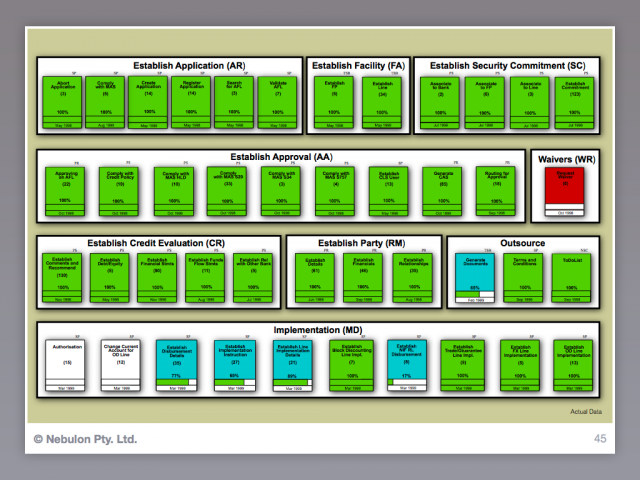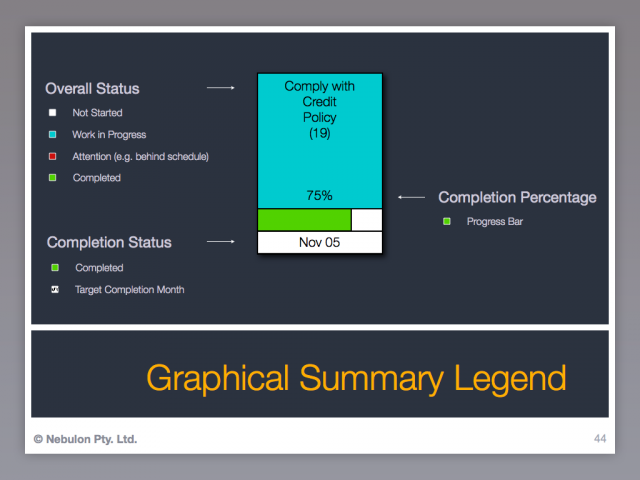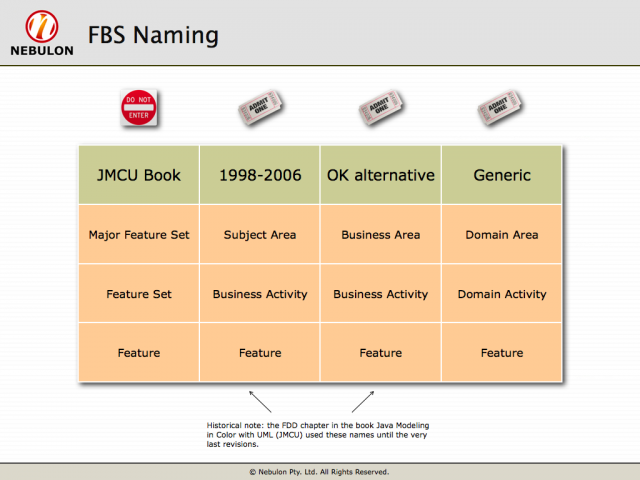Consider this as a trackback to the author's blog.
This is far from the first Excel-based implementation I've seen, but it's a nice reminder.

Consider this as a trackback to the author's blog.
This is far from the first Excel-based implementation I've seen, but it's a nice reminder.

Consider this as a trackback to the author's blog.


A slide from the Inside FDD topic in the How To Deliver Better Software Using FDD workshop.
The way this chart is presented is crucial to its communication value. The sizing, spacing, proportionality, color matching and so on; these things do matter. If you just produce colored boxes in any arrangement you lose a great deal of the communication value of this chart.


A slide from the Inside FDD topic in the How To Deliver Better Software Using FDD workshop.


A slide from the How To Run an FDD Project topic in the How To Deliver Better Software Using FDD workshop. This shows the different naming stacks for the categories in a features list. The names that ended up in the JMCU book are poor and shouldn't be used.

Here's a thought provoking article by Tim O'Reilly - Radio Forgets To Pay The User First. The radio situation is very true (as are others such as free to air TV in my country) and while satellite radio is not applicable in my country (and probably most others outside the USA) I think the iPod was the disruptive innovation here. Since I've had a good iPod in-car solution (about 18 months ago) I have just about stopped listening to radio at all. From a long term 100% of the time (in car) listener to less than an hour or two a month (on average).
The analogies that can be drawn are many and remembering to focus on your customers - to pay the users first - is the best and strongest to what we do in software development.
I am interested in the idea of combining use cases and features into a single coherent framework. In a different context, Alistair Cockburn has noted that one can match the line items of summary use cases with related high level features. For example, the use case line item “The user reviews existing claim information” Matches the feature set “system provides claim information.”
This approach provides a base linkage between use cases and feature sets. Furthermore, use case coverage and feature coverage reinforce and inform each other in a very useful way.

Werner Vogels, CTO of Amazon.com, describes on his personal weblog the effort to scan satellite images for Jim Gray's missing sailboat. Jim Gray is one of the fathers of transaction processing and his contributions to science and society go well beyond this.
Despite an extensive coast guard search, no trace has been found.
Due to a wonderful collaboration between many individuals and organizations, detailed satellite imagery of his last known whereabouts has been made available. Please review the following links and do what you can to help.
Werner Vogels - Help Find Jim Gray
Werner Vogels - Jim Gray Missing At Sea
Amazon Mechanical Turk - Help find him by searching satellite imagery
Follow the story here
 | Core J2EE Patterns: Best Practices and Design Strategies, Second Edition author: Deepak Alur,Dan Malks,John Crupi asin: 0131422464 |
Hi,
I like to know your thoughts about the creation of frameworks and the reuse of framework components in an J2EE environmet. After reading some older posts here I got the feeling that frameworks are not the way to go.
I wonder why? Isn't a framework a good thing? I see a framework as a semi-finished product which needs some domain or customer specific extras to become the final product or application. The framework we created at our company is based on one domain model and a number of components (subjects) all referencing to the one and only one model.
Hello all
So, I've been using FDD for about a year now, and I'm really enjoying running projects in this way. Today I dropped by to see if any new resources had been added, and noted the FDDi updated spec. After checking it out, I'm confused on how the new details (specifically Program and Aspect) fit into the scheme of things. Should these elements be broken down in the FBS? How would one go about doing this? Does anyone have any examples of how this all fits together?